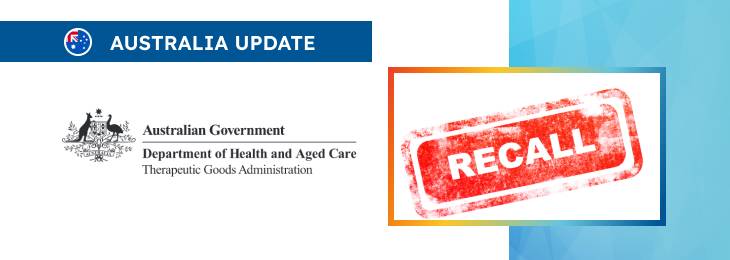The new article provides additional details regarding the subsequent steps of the recall process, including the development of an action strategy, drafting a communication strategy to be followed when conducting a recall, and also the matters related to interactions with the authority, such as the noes associated with the submission of the relevant notification and an assessment to be conducted by the TGA

Table of content
The Therapeutic Goods Administration (TGA), an Australian regulating authority in healthcare products, has published a guidance document dedicated to Uniform Recall Procedures for Therapeutic Goods (URPTG).
The document describes in detail the relevant procedures and also provides additional clarifications and recommendations the parties involved should follow in order to ensure compliance with the existing legal framework.
The authority also reserves the right to change the guidance and provision thereof, should such changes be reasonably necessary to reflect corresponding amendments to the underlying legislation.
Step 4: Developing an Action Strategy
As explained by the TGA, the recall process requires developing a robust action strategy, vitally crucial for mitigating risks associated with therapeutic goods.
This strategy is subject to agreement with regulatory bodies, emphasizing the importance of a collaborative approach.
According to the guidance, key objectives include placing on hold the distribution, sale, and use of compromised goods, rectifying or removing hazardous products, and ensuring no further dissemination of unsafe items.
Furthermore, the strategy covers notifying all the authorities involved, as well as users, together with the analysis of root causes to implement corrective and preventative measures.
The authority additionally emphasizes that the recall strategy must comprehensively address safety concerns, the nature of the issue, complaint volume, distribution specifics, and export considerations.
It also outlines recovery procedures, resource availability for field corrections, and factors influencing recall duration. As explained by the TGA, preparation entails specifying affected goods, hazard assessments, recall classifications, supply details, and incident reports.
It includes plans for collection, disposal, or correction of recalled items, customer notification for exported goods, expected closure, corrective actions taken, and key contact details.

Step 5: Drafting a Communication Strategy
By the applicable regulatory requirements, communication plays a vital role in managing recall actions, and informing stakeholders of the issues and necessary steps.
The strategy (which requires prior agreement from the TGA), includes drafting customer letters and response forms in line with the specific formatting guidelines. The timing of these communications is crucial – there is a requirement to dispatch customer letters within two business days from the moment the agreement is reached.
Additionally, consumer recall notices and media releases become essential for significant recall actions, tailored to the impacted demographic and communicated through various platforms.
The communication plan should detail the affected goods, clearly indicate the problem and associated risks, and outline consumer actions, supported by access to a toll-free contact number to be used by the interested parties in case further information is needed.
Drafts of these communications are submitted for review, with potential adjustments following expert consultation.
Step 6: Submitting the Notification
The applicable legislation establishes the procedure by submitting notifications through the TGA Business Services portal.
This process should be followed by existing organizations and newcomers initiating their first recall action.
The submission includes draft customer letters, risk documentation, distribution lists, communication strategies, and other relevant support documents.
The authority emphasizes the importance of clear and descriptive information to ensure accurate notification process.
Step 7: TGA’s Assessment of Proposed Action
Under the applicable legislation, the TGA undertakes a comprehensive assessment of the proposed recall action, focusing on risk analysis and strategy adequacy to ensure public health and safety.
This review process may result in adjustments to the recall strategy, customer communications, and public notices. While preference is given to mutually agreed strategies, the TGA retains the authority to mandate recalls if necessary.
This step also includes evaluating the proposed timeline, alternative goods availability, and potential impact on future supply.
Expert advice may be sought for risk analysis, especially when there is an uncertainty on hazard significances.
The authority additionally emphasizes that an agreement on recall types, strategies, communication plans, and written communications is essential before proceeding with the recall.
Timeframes and Notifications
The TGA commits to a seven-business-day timeframe for processing recall actions, employing a risk-based approach for initial assessments. Early advice notices may be issued for recalls impacting supply significantly, soliciting input on mitigation strategies.
It is also mentioned that direct notifications and SARA database updates should conducted, with TGA Recall Notices dispatched to relevant coordinators and parties. This ensures comprehensive stakeholder awareness and supports broader public health and safety measures.
Conclusion
The present guidance describes in detail the approach to be followed by the parties responsible for healthcare products when initiating a recall. The document pays special attention to the preparatory steps and also highlights the key points associated with the communication between the authority and manufacturers/sponsors.
How Can RegDesk Help?
RegDesk is a holistic Regulatory Information Management System that provides medical device and pharma companies with regulatory intelligence for over 120 markets worldwide. It can help you prepare and publish global applications, manage standards, run change assessments, and obtain real-time alerts on regulatory changes through a centralized platform. Our clients also have access to our network of over 4000 compliance experts worldwide to obtain verification on critical questions. Global expansion has never been this simple.

